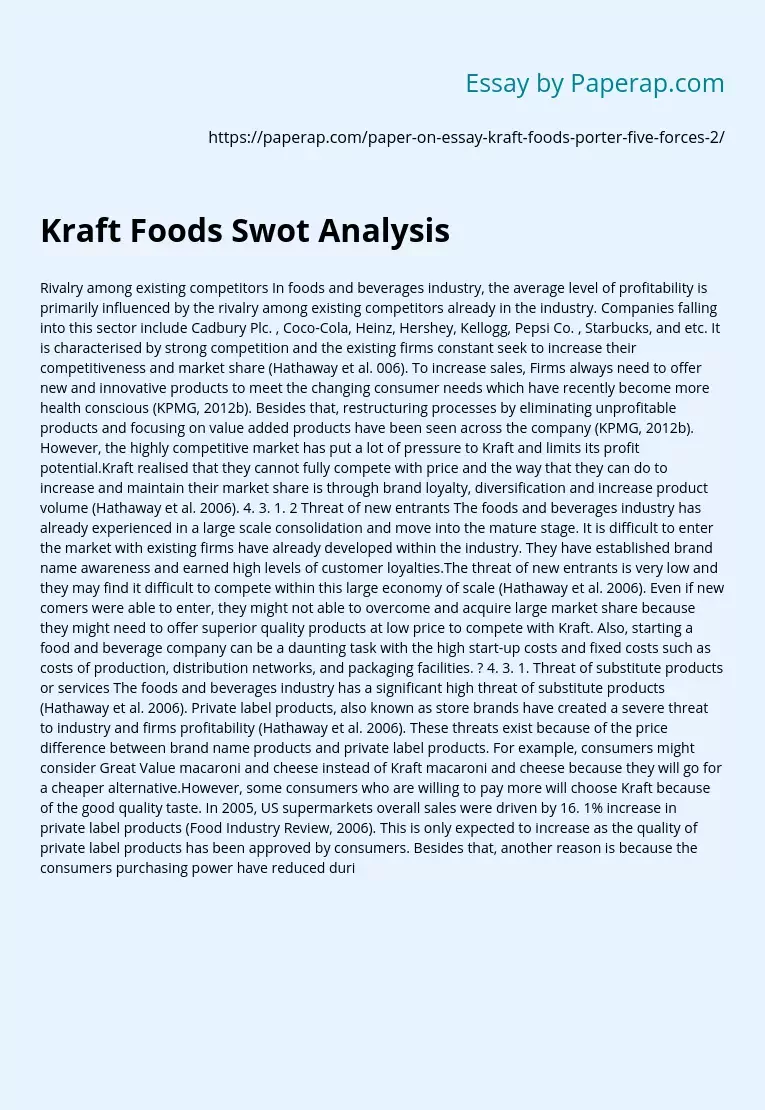Kraft Foods Swot Analysis
Rivalry among existing competitors In foods and beverages industry, the average level of profitability is primarily influenced by the rivalry among existing competitors already in the industry. Companies falling into this sector include Cadbury Plc. , Coco-Cola, Heinz, Hershey, Kellogg, Pepsi Co. , Starbucks, and etc. It is characterised by strong competition and the existing firms constant seek to increase their competitiveness and market share (Hathaway et al.
006). To increase sales, Firms always need to offer new and innovative products to meet the changing consumer needs which have recently become more health conscious (KPMG, 2012b).
Besides that, restructuring processes by eliminating unprofitable products and focusing on value added products have been seen across the company (KPMG, 2012b). However, the highly competitive market has put a lot of pressure to Kraft and limits its profit potential.Kraft realised that they cannot fully compete with price and the way that they can do to increase and maintain their market share is through brand loyalty, diversification and increase product volume (Hathaway et al. 2006).
Threat of new entrants The foods and beverages industry has already experienced in a large scale consolidation and move into the mature stage. It is difficult to enter the market with existing firms have already developed within the industry. They have established brand name awareness and earned high levels of customer loyalties.The threat of new entrants is very low and they may find it difficult to compete within this large economy of scale (Hathaway et al. 2006). Even if new comers were able to enter, they might not able to overcome and acquire large market share because they might need to offer superior quality products at low price to compete with Kraft.
Also, starting a food and beverage company can be a daunting task with the high start-up costs and fixed costs such as costs of production, distribution networks, and packaging facilities. ?
Threat of substitute products or services The foods and beverages industry has a significant high threat of substitute products (Hathaway et al. 2006). Private label products, also known as store brands have created a severe threat to industry and firms profitability (Hathaway et al. 2006). These threats exist because of the price difference between brand name products and private label products. For example, consumers might consider Great Value macaroni and cheese instead of Kraft macaroni and cheese because they will go for a cheaper alternative.However, some consumers who are willing to pay more will choose Kraft because of the good quality taste. In 2005, US supermarkets overall sales were driven by 16. 1% increase in private label products (Food Industry Review, 2006). This is only expected to increase as the quality of private label products has been approved by consumers. Besides that, another reason is because the consumers purchasing power have reduced during economic slowdown which caused them to go for cheaper products. Since these goods are elastic, a small increase in price will cause a bigger fall in demand.Therefore, this limits Kraft’s profit because these substitutes prevent Kraft to charge a higher price.
Bargaining power of suppliers In general, companies that package their products to market normally create more value-added products then the agricultural industry. Therefore, the margins of firms in the foods and beverages industry should be stay relatively consistent. Raw materials for the industry have many substitutes available and the prices are market determined, so it is difficult for suppliers to compete and gain power (Hathaway et al. 2006).However, the highly unstable prices in commodities market have put a lot of pressure to the industry. Firm’s sales will be hit hard from the impact of rising prices of oil, grain, wheat, nuts and sugar in recent years (Kollewe, 2010). For Kraft, the prices of sugar, cheese, cocoa and coffee represent a larger share of total production cost and will be add between $700 million to $800 million in business future expense (Kavilanz, 2011). Thus, although suppliers have very little bargaining power in setting prices, rising commodity prices is the major concern for both Kraft and consumers. .
Bargaining power of buyers In the current market, strong buyers can possibly extract the profitability earned in the industry by lowering the costs. Although Kraft increased prices on many of its products in the past few years because of higher raw material costs (Skidmore, 2011), but competition make it difficult to charge higher prices for their goods. In US foods and beverages industry, one of the main reasons for the increased loss in profitability is the increasing trend towards retail trade consolidation (Kraft Foods Inc, 2003).For most companies, Wal-Mart would be their largest account (Hathaway et al. 2006). Figure 9 shows where consumers are most frequently buy their goods. So, it can be said that retail business has tremendous power over its suppliers and can purchase goods as low price as possible. In 2001, grocery, candy and tobacco sales amounted to 22% of Wal-Mart’s total revenues (Grant, 2008) and were up to 30% in 2006 (Petrecca, 2011). Therefore, Kraft faces greater pressure from retail trade customers as it poses serious threat to its success and profitability.
Kraft Foods Swot Analysis. (2019, Dec 05). Retrieved from https://paperap.com/paper-on-essay-kraft-foods-porter-five-forces-2/

